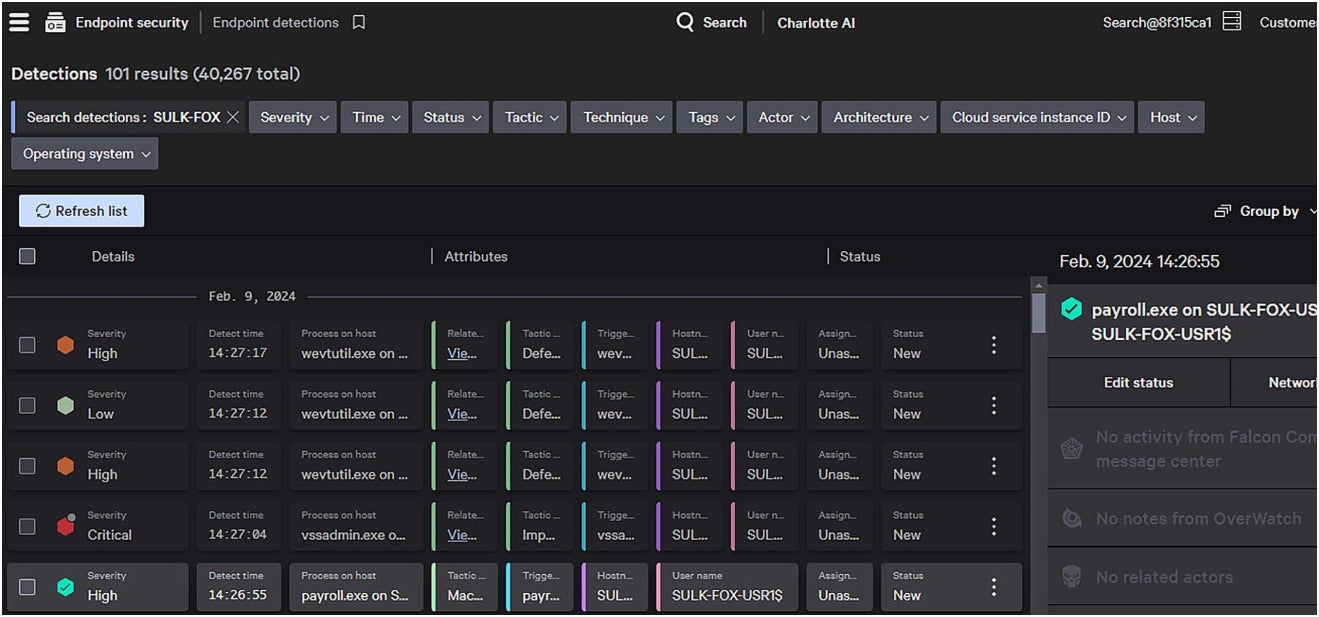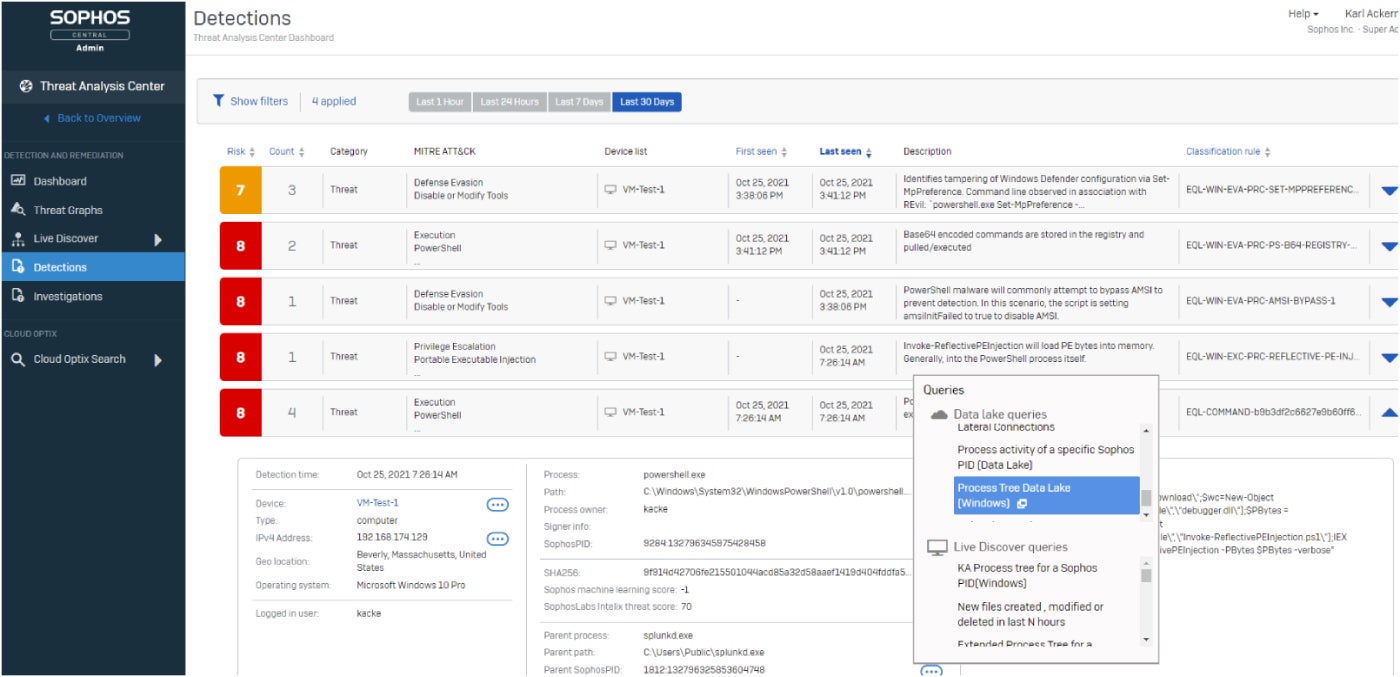As leaders within the endpoint detection and response industry, CrowdStrike and Sophos provide high-quality EDR for organizations of all sizes. Choosing between the two EDR tools can be difficult due to their similar features and reputations within the industry.
SEE: 10 Myths about Cybersecurity You Shouldn’t Believe (TechRepublic Premium)
CrowdStrike Falcon XDR and Sophos Intercept X both build upon their EDR solutions with enhanced detection and response, known as XDR.
In this comparison, we explain which EDR solution is best for you and your organization.
Feature comparison: CrowdStrike vs. Sophos
| Feature | ||
|---|---|---|
| Deep learning | ||
| Malware identification | ||
| Behavior analysis | ||
| Data loss prevention | ||
| Automated remediation | ||
| Endpoint isolation | ||
| Supported platforms | ||
| Free trial | ||
| Starting price | ||
CrowdStrike vs. Sophos pricing
In terms of pricing, Crowdstrike’s EDR and XDR can be accessed via its Falcon Enterprise or Falcon Elite subscription. While both tiers have CrowdStrike’s EDR solution, they differ in the additional security features included in the license.
Below is a rundown of the inclusions and pricing for both:
- Falcon Enterprise: $184.99 per device; includes antivirus, EDR, XDR and managed threat hunting.
- Falcon Elite: Contact sales for price quote; includes EDR, XDR, integrated endpoint and identity protection and threat-hunting.
On the other hand, Sophos’ EDR and XDR products’ pricing can be attained after answering a brief online form. I would’ve preferred it if Sophos provided both this form-based pricing and baseline prices to give businesses an idea on what prices they could expect.
SEE: CrowdStrike vs McAfee: EDR Software Comparison (TechRepublic)
Fortunately, both CrowdStrike and Sophos offer free trials for their endpoint protection products. This allows organizations to try out their software solutions without spending on an initial subscription or license.
Head-to-head comparison: CrowdStrike vs. Sophos
APIs and extensions
CrowdStrike maintains an extensive inventory of extensions, along with a robust API, to further integrate its EDR/XDR solution with an organization’s existing technology stack. These integrations make it easier for an organization to create a comprehensive and robust security landscape while including important cloud-based solutions such as AWS Security Hub and Amazon Workspaces.

Sophos also provides integrations with partners, although not as many. Sophos’s custom integrations are intended to extend the functionality of existing systems, enhancing automation and easing the administrative burden.
Accuracy
CrowdStrike was named a “Leader” in the most recent Forrester Wave Endpoint Security, Q4 2023 report. Forrester highlighted CrowdStrike as a “dominant endpoint” solution, mentioning its “superior vision” and minimal impact on endpoint performance.

In that same Forrester report, Sophos’ Endpoint software performed well but was not as highly rated as CrowdStrike. In particular, Sophos scored in the middle of the pack in terms of strategy, market presence and the strength of its current security offerings. This indicates that, at least with Forrester’s evaluations, CrowdStrike performed markedly better.
System coverage
CrowdStrike provides extensive systems coverage for all common operating systems across a wide array of potential endpoints, including Windows, Mac and Linux. This is true across the board for CrowdStrike’s current array of security products.
SEE: Microsoft Defender vs CrowdStrike: Compare EDR Software (TechRepublic)
Forrester notes that Sophos has below-average operating system coverage. Sophos provides full coverage for Windows and MacOS. While Linux is supported, not all Sophos features translate to the Linux environment. However, Sophos does support mobile platforms Android and iOS.
Performance
CrowdStrike is designed to be lightweight and easy to deploy. Not only can it be deployed for immediate use, but it has little system impact. Comparatively, some users have found Sophos resource-intensive — which could have an impact on an organization’s efficiency and performance.
Visibility
Both CrowdStrike and Sophos are designed to provide 100% visibility into your organization’s network and endpoints. These options provide both real-time and historic visibility across cloud architecture, in addition to high fidelity event data. Users note that CrowdStrike provides extensive and rich logging.
Product suite
Many security products are not used in a vacuum but rather included within a larger product suite. CrowdStrike provides an extensive array of product offerings, ranging from options in endpoint security to managed services. Some Falcon products are bundles of other, granular suites, while others are standalone. CrowdStrike’s extensive range of products may be overwhelming to some users, however.
Sophos products include Sophos Firewall, Sophos Managed Threat Response and the Sophos Central Management Console — which further integrates with Sophos Server, Sophos Switch, Sophos Mobile, Sophos Encryption and more. These products can create an entire Sophos security ecosystem, and the product line even extends to personal home security.
CrowdStrike pros and cons
Pros
- Easy to deploy and manage.
- Accurate threat detection and response.
- Lightweight compared to other clients.
Cons
- Higher price point.
- Customer service can be improved.
Sophos pros and cons
Pros
- Customizable integrations.
- Convenient centralized management console.
- Quality protection against zero-day threats.
Cons
- Need to contact Sophos for pricing.
- Found to be resource-intensive by some users.
Should your organization use CrowdStrike or Sophos?
In terms of customer experience and product capabilities, as measured by Gartner‘s user reviews and ratings, CrowdStrike Falcon XDR narrowly edges out Sophos Intercept X.
That being said, both EDR/XDR solutions are incredibly robust and provide similar feature sets. For most companies, it will come down to cost. CrowdStrike Falcon XDR is noted by MITRE testers in 2023 to have 100% protection, visibility and analytic detection across their MITRE Engenuity ATT&CK evaluations. On the other hand, Sophos Intercept X with XDR achieved a 99% detection rate of adversary behaviors in the same test.
While the performance ratings of both systems are exceptional, CrowdStrike does garner a higher overall score. Keep in mind, however, that CrowdStrike comes at a relatively higher price point as well.
Due to that trade-off, CrowdStrike Falcon XDR is likely the best option for enterprise organizations that can afford it, whereas Sophos Intercept X is an excellent solution for more budget-conscious companies.
Methodology
My comparison between CrowdStrike and Sophos’ EDR and XDR solutions involved an extensive look at their respective security features, pricing and overall value to businesses.
Specifically, I looked at essential EDR features such as threat detection accuracy, performance, extensions and API integration, deployment process and real-time visibility, among others.
Analysis for both solutions was done through comprehensive research of each product’s official documentation, feature inclusions and possible use cases for various types of organizations. We also took into account real user feedback and third-party reviews from recognized review sites to round out our final analysis and recommendations.

